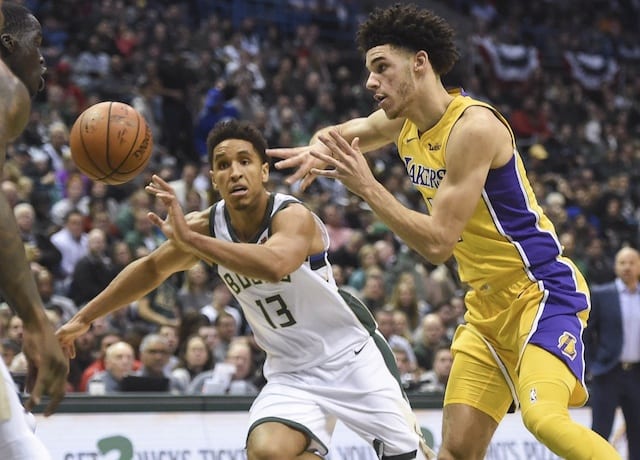Brandon Ingram, Lonzo Ball and the rest of the Los Angeles Lakers dropped a winnable game against the Phoenix Suns, and the culprit was easy to point to for anyone looking at even a basic box score: Turnovers.
The Lakers have struggled with turnovers all season even before tossing the ball away 19 times against Phoenix. Their loss to the Suns was the fourth time they’ve had that many turnovers this season, and tied for the second-most they’ve committed in any game this year (they have also turned the ball over 21 times on four separate occasions).
“[We were] just careless with the ball. A lot of those came in transition, which is a double negative because it is a scoring opportunity and we give the ball right back to them,” Ball said. “We just have to be smarter with the ball.”
Being smart with the rock shockingly hasn’t been a huge problem for the rookie despite most first-year player’s struggles with turnovers.
Even amidst his historic shooting struggles, Ball has been able to at least keep his passes on target. Of members of the team to play significant minutes, only lineups featuring Brook Lopez and Kentavious Caldwell-Pope turn the ball over less than the ones featuring Ball (15.8 percent), and lineups without him toss the ball away 18.5 percent of the time.
That small positive aside, turnovers have been a huge problem for the Lakers. The team only passes the ball 273.1 times per game (the fifth-lowest total of any team despite playing at the third-fastest pace in the NBA), and ranks just 25th in the NBA in the percentage of their baskets that are assisted (54.2 percent).
But even in that limited sample size of passes, the Lakers have still managed to be one of the most careless squads in the league with the ball, ranking 26th in assist-to-turnover ratio (1.23), 27th in turnover percentage (16.5 percent) and 29th in raw turnovers per game (17.6).
That wanton disregard for ball security was what Ingram cited as the Lakers’ biggest problem over the last few weeks after they lost five of their last six games to fall to 6-10 after a 5-5 start.
“We have to value the ball a lot more, be more physical on the defensive end and just kind of be locked in the whole game, especially on our matchups,” Ingram said.
Turning the ball over makes it a lot harder to lock in on those matchups. The Lakers have actually done pretty well at defending their opponents in transition, only allowing 1.04 points per play, the sixth-best mark in the league.
Still, that’s a worse mark than their average defense, not to mention that it’s bad process to continue to give teams easier chances to make that number change, and that a team getting out in transition usually means the Lakers and their struggling offense didn’t score, either.
The Lakers’ turnover issues have extended to their own fast breaks as well, where they cough up the rock on 17.2 percent of their possessions, the sixth-worst mark in the NBA. So even when Los Angeles does stop another team’s break with their better-than-expected transition defense and try to quickly go back the other way, they’re just as likely to give the ball right back up.
That’s a problem for a team that was hoping to — and has — played at one of the fastest paces in the league. Lakers head coach Luke Walton is right to hope that losses like the one against the Suns can serve as teachable moments for his young, turnover-prone team, but eventually the Lakers will have to actually learn the lesson, recognize when windows are too small for them to make a pass, and stop giving the ball away so often if they want to reach their ceiling.
WANT TO PARTICIPATE IN THE DISCUSSION? CHECK OUT THE NEW LAKERSNATION FORUM CLUB
